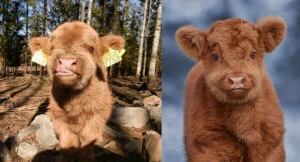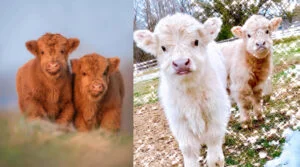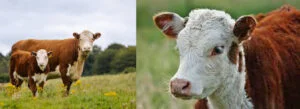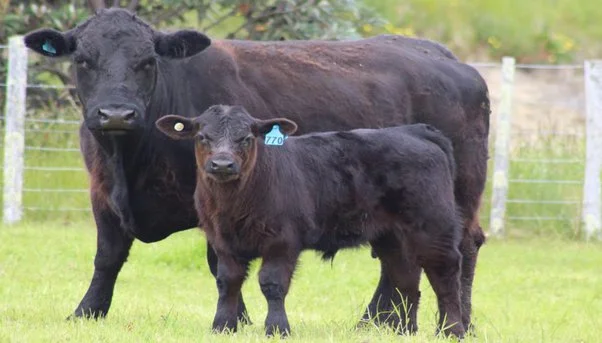
The Highland cattle, affectionately known as the ‘fluffy cow,’ is a picturesque breed originating from the rugged landscapes of the Scottish Highlands. These charming beings, with their distinctive long, wavy coats, have transcended being mere livestock; they’ve become an internet sensation, winning hearts globally.
1. Origins and History:
Highland cattle boast a rich history, dating back centuries in Scotland. Their adaptability to the harsh Highland environment made them integral to local agriculture. Over time, these bovines evolved into the iconic, long-haired breed we recognize today.
2.Distinctive Appearance:
The standout feature of the fluffy cow is undoubtedly its luxurious coat. The long, shaggy hair serves a practical purpose, providing insulation against the unpredictable Scottish weather. From a distance, Highland cattle resemble living teddy bears, evoking a sense of warmth and nostalgia.
3. Adaptability to Harsh Environments:
Well-suited to challenging climates, Highland cattle’s thick, double-layered coat shields them from cold temperatures, rain, and wind. Their sturdy build and strong hooves enable them to navigate rough terrains, showcasing their adaptability to the demanding Highlands landscape.

4. Gentle Disposition:
Beyond their captivating appearance, Highland cattle are known for their calm and gentle nature. This temperament makes them not only suitable for traditional roles in providing meat and dairy but also endears them to farmers and enthusiasts alike. Interacting with these gentle giants is often a serene and pleasant experience.
5. Role in Agriculture:
Traditionally valued for their contributions to agriculture, Highland cattle provide high-quality beef and milk. Their ability to graze on less fertile land makes them valuable for sustainable farming practices. Their docile nature also makes them easier to handle, a crucial factor for farmers.
6. Internet Celebrity Status:
In recent years, the cow has achieved celebrity status on social media platforms. Pictures and videos of these endearing creatures have gone viral, capturing the hearts of people worldwide. The internet’s fascination with Highland cattle has elevated them from mere farm animals to beloved icons of cuteness.
7. Photogenic Appeal:
The photogenic quality of Highland cattle is undeniable. Their serene expressions, framed by the long, flowing hair, make for captivating images. Photographers and enthusiasts often seek out these cows as subjects, contributing to their rise in popularity on various online platforms.
8. Conservation Efforts:
Despite their popularity, Highland cattle, like many traditional breeds, face challenges. Efforts are underway to conserve and promote these unique animals. Conservation programs aim to maintain genetic diversity and ensure the continued survival of the breed, recognizing their cultural and ecological significance.
9. Impact on Tourism:
The allure of the fluffy cow has not only impacted the online world but has also contributed to tourism in regions where Highland cattle roam. Visitors are drawn to the picturesque landscapes where these gentle giants graze, enhancing the overall appeal of rural tourism.

10. Cultural Symbolism:
Highland cattle have become symbolic of Scotland’s rich cultural heritage. Their iconic appearance is often associated with the romanticized image of the Scottish Highlands. As a cultural symbol, they represent resilience, adaptability, and a connection to the land.
11. Challenges in Modern Agriculture:
While the fluffy cow continues to be a beloved figure, modern agriculture poses challenges. Industrial farming practices often prioritize high-yield breeds, and traditional breeds like Highland cattle face competition. Balancing the preservation of these unique breeds with the demands of a changing agricultural landscape is an ongoing concern.
12. Future Prospects:
As interest in sustainable and traditional farming practices grows, the future for Highland cattle looks promising. Their ability to thrive in less-favorable conditions, coupled with the increasing emphasis on biodiversity and heritage breeds, positions them as valuable assets in the evolving landscape of agriculture.
In conclusion, the fluffy cow, represented by the enchanting Highland cattle, goes beyond its cute and cuddly appearance. It embodies a rich history, serves practical agricultural purposes, and has found a place in the hearts of people worldwide, both online and in the picturesque landscapes they call home. The story of the fluffy cow is one of resilience, cultural significance, and a harmonious connection between humans and nature.
Cows with longer, thicker coats that give them a fluffy, cuddly appearance are known as fluffy cow breeds. Breeds of fluffy cows include, for instance,
1.Hereford breed

The origin of Hereford breed cattle dates back to the 18th century in Herefordshire, England. Herefordshire is a county in the West Midlands region of England, and it is believed that this breed evolved through crossbreeding of local cattle and Welsh cattle.
Location: Hereford cattle are easily identified by their distinct white face and markings. They have a solid red or red-brown body with a white face, crest, dewlap, underline, switch, and lower legs. Their horns are usually short and stout, curving downward at the sides of the head.
Size: Hereford cattle are a medium-sized breed. Mature bulls can weigh up to 2,000 pounds, while mature cows can weigh up to 1,200 pounds. They have a long, deep body and well-developed muscles with sturdy and well-placed legs.
Temperament: Known for their gentle and friendly nature, Hereford cattle are easy to handle and are generally considered good mothers. They can survive in a variety of climates due to their adaptability.
Use: Hereford cattle are primarily raised for their quality beef production. They yield high-quality, marbled meat that is flavorful. While they are not as commonly used for dairy production as some other breeds, they do contribute to dairy farming.
Distribution: Hereford cattle are one of the most popular cattle breeds globally. They are found in all 50 states of the United States, as well as in Canada, Mexico, South America, Europe, Australia, and Asia.
Economic Significance: Hereford cattle play a significant role in the global beef industry, contributing to over 20% of the world’s beef production. They are also a popular choice for crossbreeding, enhancing the quality of meat produced by other breeds.
Conclusion: Hereford cattle are a versatile and valuable breed known for their adaptability, high-quality beef production, and amiable temperament. They have been an integral part of the global beef industry for many years and are likely to remain popular in the years to come.
2. Welsh Black breed

“The Welsh Black cattle breed is a resilient and versatile breed that has been around for centuries. They are known for their distinctive black coat, gentle nature, and adaptability to various climates.
History: The Welsh Black breed is believed to have originated from cattle brought to Britain by the Celts during the Iron Age. These early cattle were small and hardy, well-suited for the rugged Welsh climate. Over time, the Welsh Black breed was selectively bred for its desirable traits, resulting in the unique characteristics we recognize today.
Appearance: Welsh Black cattle typically have a black color, with some white allowed behind the navel line. They sport long, dense coats that help protect them from cold and wet weather. The body of Welsh Black cattle is of medium size, featuring well-developed muscles and sturdy legs. Their horns are usually short and curved.
Temperament: Welsh Black cattle are known for their docile and friendly nature. They are easy to handle, and they are often regarded as good mothers. Their adaptable temperament allows them to thrive in various climates.
Use: Welsh Black cattle are primarily raised for both their meat and milk. They produce high-quality beef with well-marbled meat that is flavorful. While they are not as commonly used for dairy production as some other breeds, they still contribute to the dairy industry.
Distribution: Welsh Black cattle are found not only throughout the United Kingdom but also in many other countries worldwide. They are particularly popular in North America, Australia, and New Zealand.
Economic Significance: Welsh Black cattle play a crucial role in both the global beef and dairy industries. It is estimated that they contribute to more than 5% of the world’s beef production. Additionally, the Welsh Black breed is a popular choice for crossbreeding, enhancing the quality of meat produced by other breeds.
Conclusion: In conclusion, Welsh Black cattle are a versatile and valuable breed suitable for various climates and production systems. They are known for their high-quality beef and milk, gentle temperament, and adaptability. Welsh Black cattle continue to be a significant part of the global beef and dairy industries and are likely to remain popular for many years to come.
3. Whitebred Shorthorn breed

Introduction: Whitebred Shorthorn cattle are a breed originating primarily from the border counties of England and Scotland. While they belong to the Shorthorn cattle category, unlike other Shorthorn varieties, they are always white.
Physical Characteristics: These cattle are of medium size, with the weight of cows averaging around 550-600 kilograms and bulls weighing 800-900 kilograms. They have a long, robust body with a well-covered layer of quality meat. Their coat is white, featuring a thick, coarse undercoat that helps them withstand cold and wet weather. Known for their gentle and friendly nature, Whitebred Shorthorns are easy to handle and are generally recognized as good mothers. They belong to a robust breed capable of thriving in various climates.
Primary Use: Whitebred Shorthorn cattle are primarily raised for their meat. They produce high-quality beef that is well-marbled and flavorful. While they are not as commonly used for dairy production as some other breeds, they still contribute to the dairy industry.
Key Features of Whitebred Shorthorn Cattle:
- Color: White
- Size: Medium
- Temperament: Gentle and friendly
- Use: Meat and, to a lesser extent, dairy production
- Distribution: United Kingdom, Australia, New Zealand, North America
- Economic Significance: Vital to the global beef and dairy industries
Interesting Facts about Whitebred Shorthorn Cattle:
- Whitebred Shorthorns are considered a rare breed.
- They are often crossbred with other cattle breeds, such as Galloway and Highland cattle.
- Whitebred Shorthorns are known for their good maternal instincts.
- They make an excellent choice for organic beef production.
In conclusion, Whitebred Shorthorn cattle are a valuable breed suitable for various climates and production systems. They are known for their high-quality beef, gentle nature, and adaptability. Whitebred Shorthorns play a crucial role in the global beef and dairy industries and are likely to remain popular for years to come.
4. Shetland breed

Overview: Nestled amidst the captivating landscapes of the Shetland Islands, Shetland cattle stand out as a resilient breed that has won hearts with their gentle demeanor and unique presence. These compact, sturdy cattle have played a crucial role in the agricultural heritage of the region, carving a special place in Scottish culture.
Distinctive Features: Shetland cattle are easily recognizable by their long, shaggy coats, which can come in colors ranging from black and white to red and white. Their horns, typically short and curvy, add to their unique charm. Standing at around 1.2 meters in length, Shetland cattle are a small breed, with an average weight of 350 to 450 kilograms for cows and 550 to 600 kilograms for bulls.
Rich History: The origins of Shetland cattle can be traced back to the Viking Age, with evidence suggesting their presence in the Shetland Islands as early as the 8th century. These early cattle, likely descendants of European wild cattle, proved invaluable for their ability to thrive in the harsh Shetland climate.Over the centuries, Shetland cattle evolved, adapting to their environment, developing distinctive traits, and becoming an integral part of island life. They provided valuable milk and meat, and their hides were used for various purposes, showcasing their versatility.
Adaptability and Multifaceted Abilities: Shetland cattle are renowned for their resilience and adaptability. Their compact size allows them to navigate the challenging terrains of the Shetland Islands, while their thick coats provide protection. Known for their easygoing nature, they are easy to handle, earning them the endearing nickname of “Gentle Giants.” Today, Shetland cattle are primarily raised for their meat, known for its tenderness, flavor, and high nutritional value. The breed’s versatility extends to dairy production, with Shetland cows producing milk rich in butterfat, ideal for making butter and cheese.
Cultural Significance: Beyond their practical value, Shetland cattle hold deep cultural significance for the Shetland Islands. They are often featured in traditional festivals and events, enhancing the allure of local products and landmarks. Shetland cattle symbolize the spirit of the Shetland people, embodying resilience, adaptability, and multifaceted talent.
Conservation Efforts: In recent decades, changes in agricultural practices and the introduction of larger, more modern breeds have posed challenges to the population of Shetland cattle. Conservation efforts, however, have played a crucial role in revitalizing the breed, ensuring that Shetland cattle continue to be a stable and valuable asset to Scottish agriculture.
Conclusion: Shetland cattle, with their unique presence, gentle nature, and rich history, are a symbol of the Shetland Islands. Their resilience, adaptability, and multifaceted abilities make them a valuable heritage breed, ready to carry their legacy forward as conservation efforts continue.
5. Belted Galloway Cattle Breed

Introduction: Belted Galloway cattle, known for their unique white belts that encircle their bodies amidst a contrasting black, dun, or red coat, are a breed of beef cattle. Originating in the rugged landscapes of southwest Scotland, they have become a symbol of Scottish heritage, thriving in harsh climates.
History and Origin: The exact origin of Belted Galloway cattle is somewhat unclear, but they are believed to be descendants of ancient cattle that roamed the Scottish Highlands centuries ago. Over time, selective breeding practices led to the development of the distinctive white belt, thought to have originated through crossbreeding with Dutch Lakenvelder cattle.
Characteristics and Temperament: Belted Galloways are of medium size, with cows weighing between 450-600 kilograms and bulls ranging from 750-1000 kilograms. Their thick, double coats provide insulation against chilly winters and protect them from harsh weather conditions. These cattle are known for their gentle and amiable nature, making them easy to handle and manage.
Utility and Significance: Primarily raised for their high-quality beef, Belted Galloway cattle are renowned for marbled meat, tenderness, and exquisite flavor. Their meat is often compared to game meat, resembling the taste of venison. Additionally, Belted Galloways contribute to dairy production, producing milk ideal for butterfat-rich products like butter and cheese.
Cultural Importance: Beyond their practical uses, Belted Galloway cattle play a vital role in Scottish culture and heritage. They are often featured in traditional Highland games and festivals, enhancing the charm of Scottish tourism and products. Their unique presence and friendly nature have made them a beloved symbol of Scotland.
Conservation and Preservation: Despite their adaptability, Belted Galloway cattle faced a decline in numbers during the 20th century due to changes in agricultural practices and the introduction of modern cattle breeds. Conservation efforts, however, have played a crucial role in revitalizing the population. Organizations like the Belted Galloway Cattle Society are dedicated to preserving the purity of the breed and promoting its continuous use in agriculture for meat and dairy production. These efforts have successfully maintained the breed’s genetic diversity and secured its place in the Scottish agricultural landscape.
Conclusion: Belted Galloway cattle stand as a unique and valuable breed, contributing significantly to Scottish history and culture. Their distinctive presence, friendly nature, and adaptability have made them a popular choice for beef production and a cherished symbol of Scotland. With ongoing conservation initiatives, Belted Galloway cattle are poised to continue their legacy as icons of Scottish heritage and culinary excellence.
For more page.

1 thought on “Details of the Fluffy Cow and its Breed.”